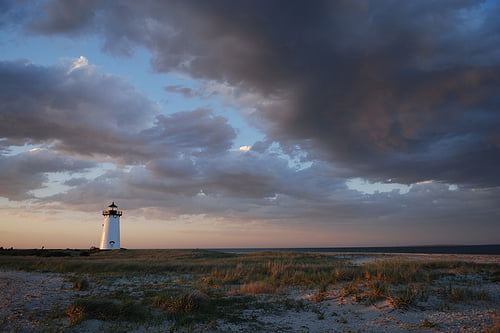
Whale songs are part of Martha’s Vineyard Live Music Playlist!
If you look out on the Edgartown harbor today, you will see sailboats and other leisure craft lolling in the blue-green water. But in centuries past, this scene was very different and likely much less picturesque: scruffy men carrying harpoons boarded the vessels that would scour the sea in search of whales.
Whaling is an important part of Martha’s Vineyard’s maritime traditions and sea-faring adventures. And even though in today’s environmentally conscious times the idea of whale hunting is unthinkable, in those long-ago days it was considered to be an economic necessity. The oil derived from these aquatic mammals was not only widely used in the manufacture of every-day products like soap, textiles, candles, and paints, but it also lubricated the machines during the Industrial Revolution.
And, it kept Martha’s Vineyard population in the 18th until mid-19th centuries from falling into poverty. As the 2006 New York Times article reported, “whale hunting and processing just about built the economic infrastructures of New Bedford, Cape Cod, Nantucket, and Martha’s Vineyard. During those halcyon years, sea captains’ homes were the most lavish in town, and widow’s walks on rooftops became all the rage as families waited for their men to return from as long as three years at sea.”
Man versus beast
The whaling began on Martha’s Vineyard during the early 1700s, when colonists and the Native American Wampanoags profited from the abundance of whales swimming in local waters. As the New York Times article related in 2006 “the Wampanoags, in particular, used all parts of the whale, including its meat, oil, and bones. So important were whales to Wampanoag culture that the tribe often stipulated rights to offshore whaling and beached whales whenever they sold land to the whites.”
As a matter of fact, the great 1851 American novel, “The Moby Dick,” has a character named Tashtego, an Aquinnah Wampanoag Indian who was a highly skilled harpooner.
However, by the mid-18th century, the whale population off the shore of the island had been depleted, due, in large part, to the unrelenting hunting activity of the preceding decades. It had become necessary to use large vessels and venture farther away from the shore to catch the whales. Both Edgartown and Vineyard Haven became important whaling ports, and the vestiges of those days still remain.
Facing Edgartown’s harbor, impressive captains’ mansions are still standing, as well as Main Street’s stately Old Whaling Church. The Fisher House, built in 1840 for Daniel Fisher, a whaling ship owner and the primary supplier of whale oil in the region, is one of the local landmarks, and open for public tours.
Songs of the sea
Around the middle of the 19th century, as the whale population around Martha’s Vineyard plummeted (due to centuries of whale hunting) and new methods of fuel production were invented, whaling was no longer an important industry, though fishing – another maritime activity – still thrives on the island.
These days, when the preservation of wildlife is a priority, we see whales within the bigger picture of environmental and aquatic biodiversity. We at Martha’s Vineyard Live music especially love what we call “the underwater melodies” that the whales compose and perform.
Just like the island’s human musicians and bands, our whales too can carry an ear-pleasing tune!


